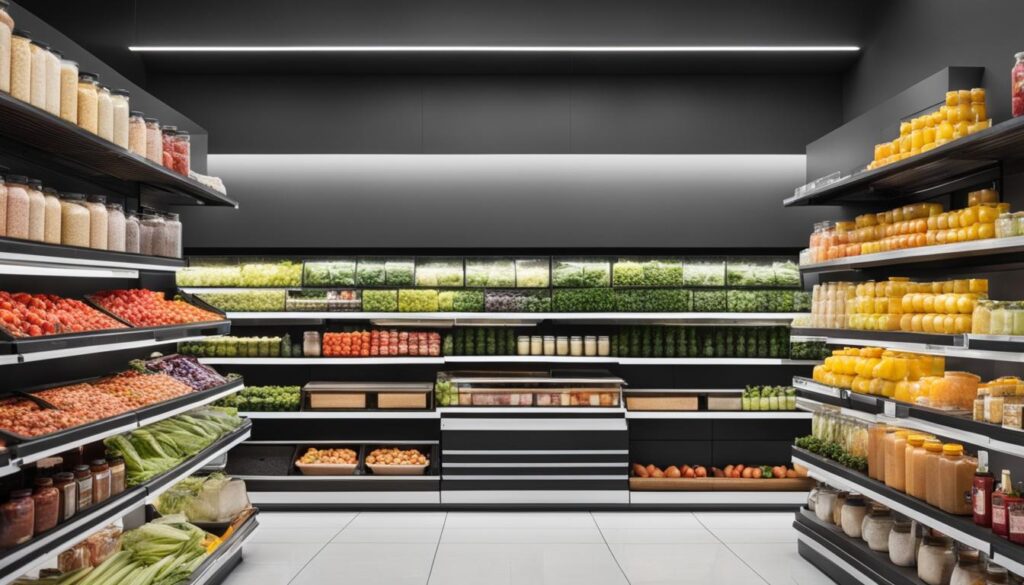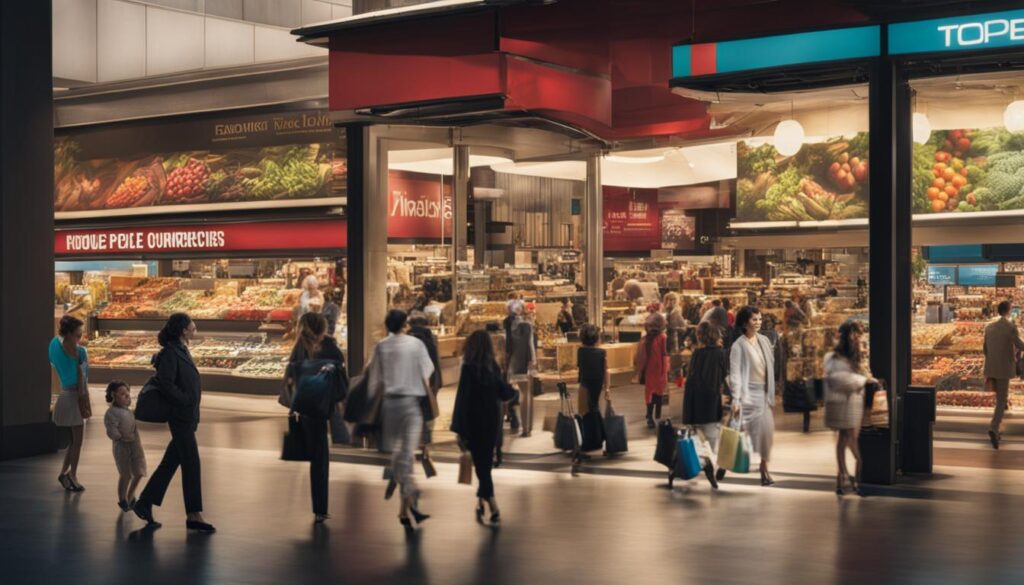When it comes to shopping, having a wide range of options can seem like a dream come true. However, research shows that too many choices can actually lead to decision-making difficulties and dissatisfaction with our purchases. This phenomenon, known as the paradox of choice, has significant implications for consumer psychology and shopping habits.
In his book “The Paradox of Choice – Why More Is Less,” author Barry Schwartz explores how eliminating consumer choices can reduce anxiety and improve the shopping experience. He introduces the concept of maximizers, who aim for the best possible choice, and satisficers, who settle for a choice that meets their criteria. Excessive choices can overwhelm maximizers, leading to regret and dissatisfaction.
Key Takeaways:
- The paradox of choice refers to the phenomenon where having too many options can lead to decision-making difficulties and dissatisfaction.
- Eliminating consumer choices can reduce anxiety and improve the shopping experience.
- Maximizers aim for the best possible choice, while satisficers settle for a choice that meets their criteria.
- Excessive choices can overwhelm maximizers, leading to regret and dissatisfaction.
- Understanding the impact of the paradox of choice can help retailers optimize their offerings and improve customer satisfaction.
The Psychology of Choice Overload
When faced with a large number of options, consumers may experience choice overload, which can lead to decision-making difficulties and dissatisfaction with the chosen option. Research has shown that having too many options can overwhelm consumers, making it harder for them to make a decision. This phenomenon, known as choice overload, has been studied extensively in the field of consumer psychology.
One famous study conducted by Sheena Iyengar and Mark Lepper, known as the jam study, demonstrated the effects of choice overload. They set up a display of jams in a grocery store, alternating between having a large variety of jams and a small selection. Surprisingly, they found that while the larger display attracted more attention, the smaller display resulted in more sales. This suggests that having too many options can actually deter consumers from making a purchase.
“Studies have shown that when presented with too many options, consumers are less likely to make a purchase.”
One explanation for this phenomenon is the cognitive effort required to evaluate and compare numerous options. As the number of choices increases, consumers need to spend more time and mental energy on decision-making. This can lead to decision fatigue, where individuals become mentally exhausted and less confident in their choices. Ultimately, choice overload can result in a less satisfying shopping experience for consumers.
| Effects of Choice Overload | Strategies to Overcome Choice Overload |
|---|---|
| – Decision-making difficulties | – Setting clear goals and priorities |
| – Dissatisfaction with chosen option | – Limiting the number of options considered |
| – Decision fatigue | – Seeking recommendations from trusted sources |
Understanding the psychology of choice overload is essential for retailers who want to optimize the shopping experience for their customers. By offering a curated selection of options and providing clear information and guidance, retailers can help consumers navigate through choices more easily. Additionally, implementing strategies such as default options or personalized recommendations can help alleviate the effects of choice overload, making the decision-making process simpler and more satisfying for consumers.
The Paradox of Choice and Consumer Behavior
The paradox of choice has a significant impact on consumer behavior, influencing their satisfaction and buying decisions. While having more choices may appear desirable, research has shown that an excessive number of options can lead to decreased consumer satisfaction and a lower likelihood of making a purchase. Understanding the concept of satisficing, where consumers choose options that are “good enough” rather than striving for the best, becomes crucial in this context.
Choice architecture techniques can be employed by retailers to guide consumer decision-making and enhance satisfaction. By organizing options in a way that is easy to navigate and highlighting recommended choices, retailers can help consumers make informed decisions. For example, categorizing products into clearly defined sections and providing detailed product descriptions and comparisons can simplify the decision-making process.
Consumer behavior can also be influenced by factors such as social proof and personalized recommendations. Utilizing strategies such as customer reviews, ratings, and testimonials can help build trust and influence buying decisions. Additionally, offering personalized recommendations based on individual preferences can enhance the overall shopping experience and increase customer satisfaction.
Table: Factors Influencing Consumer Behavior
| Factors | Description |
|---|---|
| Satisficing | Consumers choosing options that are “good enough” instead of striving for the best |
| Choice Architecture | Strategies employed by retailers to guide consumer decision-making |
| Social Proof | Influencing consumer behavior through customer reviews, ratings, and testimonials |
| Personalized Recommendations | Offering tailored suggestions based on individual preferences to enhance the shopping experience |
Understanding the impact of the paradox of choice on consumer behavior enables retailers to optimize their offerings and improve customer satisfaction. By simplifying the decision-making process, providing clear information, and leveraging factors that influence consumer behavior, retailers can create a more satisfying shopping experience for their customers.
The Influence of Choice Architecture
Choice architecture plays a crucial role in guiding decision-making and influencing consumer behavior. By strategically designing the way choices are presented and organized, retailers can nudge customers towards making desired decisions. This concept takes advantage of cognitive biases, such as the familiarity bias and the decoy effect, to shape consumer preferences.
One effective technique used in choice architecture is the use of default options. By preselecting a certain choice as the default, retailers can influence customers to stick with that option out of convenience or inertia. This approach has been shown to significantly impact decision-making, as individuals tend to go with the default when faced with complex choices. For example, offering a default shipping option on an e-commerce website can simplify the decision-making process for customers.
Another strategy in choice architecture is limiting choices. By offering a curated selection of options, retailers can reduce decision fatigue and make the decision-making process more manageable for customers. Research has shown that having a limited number of choices can increase decision satisfaction and the likelihood of making a purchase. For instance, a restaurant that offers a concise menu with carefully selected dishes can help customers make decisions more easily and enjoy their dining experience.
| Choice Architecture Techniques | Benefits |
|---|---|
| Default options | Influences decision-making by preselecting a certain choice |
| Limited choices | Reduces decision fatigue and increases decision satisfaction |
| Highlighting recommended choices | Guides customers towards options that align with their preferences |
Additionally, highlighting recommended choices is another effective choice architecture technique. By drawing attention to specific options, retailers can guide customers towards choices that are likely to align with their preferences. This can be achieved through visual cues, such as displaying “popular” or “recommended” labels on certain products. By leveraging choice architecture techniques, retailers can optimize the shopping experience and increase customer satisfaction.
The Role of Limited Options
Research suggests that having a limited number of options can lead to increased decision-making satisfaction. When faced with a smaller number of choices, consumers can evaluate and compare options more effectively, leading to a higher likelihood of making a satisfying decision. For example, the jam study mentioned earlier showed that consumers were more likely to make a purchase when presented with a smaller selection of jams. By offering a carefully curated selection of options, retailers can help consumers make decisions more easily and increase their overall satisfaction.
Table:
| Options Provided | Decision-Making Satisfaction |
|---|---|
| Large number of options | Low |
| Limited number of options | High |
By limiting options, retailers can also reduce decision fatigue. When faced with too many choices, consumers can become overwhelmed and experience cognitive strain, making it harder for them to make a decision. Limiting options helps alleviate this burden by streamlining the decision-making process. Additionally, it allows consumers to focus on the most relevant criteria and make a choice that best aligns with their preferences and needs.
Offering a limited selection of options does not mean compromising variety or quality. By carefully curating their offerings, retailers can ensure that the available choices cater to different preferences and offer sufficient diversity. This approach strikes a balance between freedom of choice and simplicity, providing consumers with a manageable selection that enhances their decision-making satisfaction.
Balancing Freedom and Overwhelm
While freedom of choice is often associated with increased autonomy and happiness, the paradox of choice highlights the potential negative impact of excessive choices. Having an overwhelming number of options can lead to anxiety and decision-making difficulties. It is important to strike a balance between offering variety and overwhelming consumers. By providing a manageable number of options and facilitating decision-making through clear information and guidance, retailers can enhance the shopping experience and alleviate the negative effects of choice overload.
Choice overload can create feelings of anxiety and overwhelm, making it difficult for consumers to make decisions confidently. This can lead to decision-making paralysis, where consumers either delay their purchase or feel unsatisfied with their choice. Retailers need to be mindful of this and take steps to simplify the decision-making process for their customers.
One strategy that retailers can employ is to classify options and present them in a clear and organized manner. Categorizing products into relevant sections and providing filters can help consumers navigate through choices more easily. Additionally, offering personalized recommendations based on individual preferences can help consumers narrow down their options and make decisions with more confidence.
By understanding the psychological factors that influence decision-making, retailers can create a shopping experience that balances freedom of choice with manageable options. This can help alleviate the anxiety and overwhelm associated with excessive choices, leading to a more satisfying shopping experience for consumers.
Strategies to Overcome the Paradox of Choice
Overcoming choice overload and simplifying decision-making can significantly enhance satisfaction in the shopping process. Here are several effective strategies that individuals can employ:
- Set clear goals and priorities: Before starting the decision-making process, it is important to define what truly matters to you. This helps to focus on the most relevant options and reduces the influence of irrelevant choices. By setting clear goals, you can streamline your decision-making and make choices that align with your priorities.
- Limit the number of options: Trying to consider every possible choice can be overwhelming and contribute to decision fatigue. Instead, set specific criteria for your decision and eliminate choices that do not meet those criteria. By narrowing down the options, you can simplify the decision-making process and make it more manageable.
- Seek recommendations and reviews: Seeking guidance from trusted sources can provide valuable insights and help you make informed decisions. Online reviews, recommendations from friends or family, and expert opinions can help you narrow down your choices and increase confidence in your decision-making.
By implementing these strategies, individuals can effectively navigate the paradox of choice and simplify the decision-making process, leading to enhanced satisfaction with their chosen option.

“Simplifying the decision-making process is essential for overcoming choice overload and enhancing satisfaction in shopping.” – Consumer Behavior Expert
Retailers’ Role in Simplicity and Satisfaction
When it comes to shopping, retailers play a crucial role in enhancing the overall experience for customers. By prioritizing simplicity and curating product offerings, retailers can significantly improve customer satisfaction. Simplicity in shopping means providing a streamlined and user-friendly experience that helps customers make informed decisions with ease.
One way retailers can achieve simplicity is by carefully selecting and organizing their product offerings. By curating a range of high-quality options that meet customer needs and preferences, retailers can reduce choice overload and make the decision-making process more manageable. Categorizing products in a logical manner and providing clear information about their features and benefits can further enhance simplicity.
Moreover, retailers can enhance customer satisfaction by implementing user-friendly interfaces and personalized recommendations. User-friendly interfaces simplify the shopping process by making navigation intuitive and seamless. Personalized recommendations based on customer preferences help shoppers discover products that align with their individual needs and preferences, enhancing their overall satisfaction. By leveraging data and technology, retailers can create a more tailored and personalized shopping experience.

| Benefits of Retailers’ Focus on Simplicity | Enhanced Customer Experience |
|---|---|
| 1. Reduced choice overload | 1. Streamlined decision-making |
| 2. Improved decision-making satisfaction | 2. Increased customer loyalty |
| 3. Easier product comparison | 3. Higher likelihood of repeat purchases |
| 4. Clear and concise information | 4. Positive brand perception |
“By prioritizing simplicity and curating product offerings, retailers can significantly improve customer satisfaction.”
The Impact of Simplicity on Customer Loyalty
Providing a simplified shopping experience not only enhances customer satisfaction but also contributes to increased customer loyalty. When customers find the shopping process effortless and enjoyable, they are more likely to return to the same retailer for future purchases. By reducing choice overload and facilitating informed decision-making, retailers can build trust and loyalty with their customer base.
Moreover, simplicity in shopping can lead to positive word-of-mouth referrals, further contributing to customer loyalty. Satisfied customers are more likely to recommend a retailer to their friends, family, and colleagues. This organic form of marketing can help retailers expand their customer base and strengthen their brand reputation.
In conclusion, retailers have a critical role to play in simplifying the shopping experience and enhancing customer satisfaction. By curating product offerings, implementing user-friendly interfaces, and offering personalized recommendations, retailers can create a more streamlined and enjoyable shopping process. Prioritizing simplicity not only leads to improved customer satisfaction but also contributes to increased customer loyalty and positive word-of-mouth referrals. By embracing simplicity, retailers can set themselves apart in a competitive market and build strong relationships with their customers.
The Future of Choice in Shopping

The future of choice in shopping is poised to be shaped by evolving consumer preferences. As consumers become more empowered and tech-savvy, their expectations for personalized and customized experiences continue to grow. Retailers will need to adapt to meet these demands, harnessing the power of personalization and customization to provide tailored offerings that align with individual needs and preferences.
Personalization is the key to unlocking consumer satisfaction and loyalty. By leveraging technology such as artificial intelligence and machine learning, retailers can analyze vast amounts of consumer data to gain insights into individual preferences, purchase history, and browsing behavior. This data allows retailers to deliver personalized recommendations, tailored promotions, and customized shopping experiences that resonate with each customer on a personal level.
Customization takes personalization a step further, empowering consumers to have a direct hand in shaping the products they purchase. From customizable clothing and accessories to personalized home decor and tech gadgets, the ability to personalize products according to individual tastes and preferences enhances the sense of ownership and uniqueness.
The Rise of Experience-driven Shopping
Today’s consumers seek more than just products; they desire memorable and immersive shopping experiences. The future of choice in shopping will involve creating experiential environments that cater to consumers’ senses, emotions, and aspirations. Retailers will need to think beyond traditional brick-and-mortar stores and embrace innovative technologies such as virtual reality, augmented reality, and interactive displays.
“The future of choice in shopping lies in creating personalized and memorable experiences that exceed consumer expectations.” – Retail Industry Expert
Imagine being able to virtually try on clothes, visualize how furniture would look in your home, or receive personalized recommendations from virtual shopping assistants. These immersive experiences not only enhance the shopping journey but also provide retailers with valuable data about consumer preferences and behaviors.
In conclusion, the future of choice in shopping is driven by evolving consumer preferences, with a focus on personalization, customization, and experience-driven shopping. Retailers that adapt to these changing dynamics by leveraging technology and understanding individual needs will thrive in the competitive retail landscape.
The Impact of the Paradox of Choice on Well-being
The paradox of choice not only affects the shopping experience but can also have an impact on overall well-being. Studies have shown that excessive choices can lead to decision fatigue, increased stress, and decreased life satisfaction. The psychological effects of choice overload can be detrimental to one’s well-being, as the constant evaluation and comparison of options can be mentally exhausting.
When faced with a multitude of choices, individuals may experience a sense of anxiety and fear of making the wrong decision. This can result in decision paralysis, where individuals are unable to make a choice and feel overwhelmed by the available options. This constant state of indecision can take a toll on mental health and contribute to feelings of dissatisfaction and unhappiness.
Furthermore, the dissatisfaction that can arise from the paradox of choice can extend beyond the shopping experience. It can spill over into other areas of life, such as relationships and career choices. The constant pursuit of finding the “perfect” option can lead to a perpetual sense of dissatisfaction and a never-ending cycle of searching for something better.
The Importance of Decision Satisfaction
Decision satisfaction plays a crucial role in overall well-being. When individuals feel satisfied with their choices, they experience a sense of fulfillment and contentment. On the other hand, when choices are made under the pressure of excessive options or a fear of missing out, individuals may experience regret and a decrease in overall life satisfaction.
To mitigate the negative impact of the paradox of choice on well-being, it is important for individuals to find ways to simplify decision-making. This can be achieved by setting clear priorities, limiting the number of options considered, seeking external guidance when needed, and focusing on what truly matters to them. By taking these steps, individuals can reduce decision fatigue, alleviate stress, and enhance their overall well-being.
| Psychological Effects of the Paradox of Choice | Well-being Impact |
|---|---|
| Decision fatigue | Decreased life satisfaction |
| Increased stress | Heightened anxiety |
| Indecision and decision paralysis | Feelings of overwhelm and dissatisfaction |
| Constant search for the “perfect” option | Perpetual dissatisfaction and unfulfillment |
| Regret from fear of missing out | Decreased overall life satisfaction |

“The constant pursuit of finding the ‘perfect’ option can lead to a perpetual sense of dissatisfaction and a never-ending cycle of searching for something better.”
By recognizing the potential negative psychological effects of the paradox of choice and implementing strategies to simplify decision-making, individuals can protect their well-being and cultivate a more fulfilling and satisfying life.
Conclusion
The paradox of choice poses a significant challenge in the world of shopping, where an overwhelming number of options can lead to decision-making difficulties and ultimately, dissatisfaction. However, by understanding the psychological factors at play, both individuals and retailers can implement strategies to simplify decision-making and enhance customer satisfaction.
Striking a balance between freedom of choice and manageable options is key. By providing a curated selection of choices and organizing them in a user-friendly manner, retailers can help consumers navigate through options more easily. Clear and concise information about product features and benefits can also facilitate decision-making, empowering shoppers to make informed choices.
To overcome the paradox of choice, individuals can set clear goals and priorities, focusing on what truly matters to them. Limiting the number of options considered by setting specific criteria can also streamline the decision-making process. Seeking recommendations from trusted sources and utilizing online reviews can provide valuable insights and increase confidence in decision-making.
By reducing choice overload and facilitating decision-making, individuals can have a more satisfying shopping experience. Simplifying the decision-making process and enhancing satisfaction will continue to be crucial in navigating the ever-evolving landscape of consumer preferences. Ultimately, by understanding the impact of the paradox of choice and implementing effective strategies, both individuals and retailers can create a more enjoyable and fulfilling shopping experience.
FAQ
What is the paradox of choice?
The paradox of choice refers to the phenomenon where having too many options can lead to decision-making difficulties and dissatisfaction with the chosen option.
Who introduced the concept of the paradox of choice?
The concept of the paradox of choice was introduced by Barry Schwartz in his book “The Paradox of Choice – Why More Is Less.”
What are maximizers and satisficers?
Maximizers are individuals who strive to find the best possible choice, while satisficers are individuals who settle for a choice that meets their criteria.
How does choice overload impact consumer behavior?
Excessive choices can overwhelm consumers, leading to regret, dissatisfaction, and a decreased likelihood of making a purchase.
What is choice architecture?
Choice architecture refers to the way choices are presented and organized, influencing decision-making. Retailers can strategically design their store layouts and online interfaces to guide consumers towards certain choices.
How can limited options enhance decision-making satisfaction?
Research suggests that having a limited number of options can lead to increased decision-making satisfaction, as it allows for easier evaluation and comparison of choices.
How can retailers balance freedom of choice and overwhelm?
Retailers can strike a balance by offering a manageable number of options and providing clear information and guidance to facilitate decision-making.
What strategies can individuals use to overcome the paradox of choice?
Individuals can set clear goals and priorities, limit the number of options considered, and seek recommendations from trusted sources to simplify decision-making.
How can retailers enhance customer satisfaction?
Retailers can curate their product offerings, categorize them in a user-friendly manner, provide clear information, and offer personalized recommendations based on customer preferences.
How can technology influence the future of choice in shopping?
Technology, such as artificial intelligence and machine learning, can analyze consumer data and deliver personalized recommendations, enhancing the shopping experience.
What impact does the paradox of choice have on well-being?
Excessive choices can lead to decision fatigue, increased stress, and decreased life satisfaction. Simplifying decision-making can help improve overall well-being.
How Does the Paradox of Choice Affect Financial Decision Making?
The paradox of choice and financial health is a complex relationship. While having numerous options might seem advantageous, research suggests that too many choices can lead to decision paralysis and poor financial outcomes. It’s important to strike a balance between variety and simplicity to make better financial decisions and maintain overall financial well-being.

